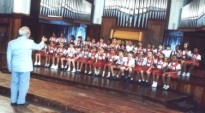11.12.2 Rafael Somavilla.

Rafael Somavilla, Cuban pianist, arranger, composer, and orchestra conductor, was born on August 9, 1927, in the province of Matanzas. He enrolled in the Falcón Academy in his home province, where he studied piano, a musical instrument he played majestically by the time he was just 11 years old. By then, Somavilla was already working as a pianist in the orchestra his father conducted.
In 1951, Rafael arrived in Havana, the Cuban capital. He worked wherever he was called, as well as in various clubs and cabarets throughout the city. A year later, he was asked to play piano at the Capri cabaret (21st Street between North and West, Vedado, Plaza de la Revolución, Havana), where he also began making some musical arrangements.
Somavilla participated in the creation and inauguration of the Cuban Jazz Club at the Bambú cabaret, as he was a fan of this musical genre. He directed and was the first president of the orchestra, which included prominent Cuban musicians, including Cheo Valladares (who sang guarachas and played maracas), Leonardo Timor (trumpet), Amadito Valdés and Luis Barreras (alto saxophones), and Cachaíto López (double bass).
By this time, Rafael Somavilla had a well-deserved reputation as a musician and orchestra conductor. As a result of his musical prowess, he was appointed conductor of the Parisién cabaret orchestra, located in the Hotel Nacional de Cuba (O Street and 21st Street, Vedado, Plaza de la Revolución, Havana), in 1955. Later, in 1959, he became conductor of the Caribe cabaret orchestra at the Hotel Habana Libre (L Street and 23rd Street, Vedado, Plaza de la Revolución, Havana).
In 1963, he led the important orchestra of the Cuban Institute of Radio Broadcasting (ICR). With this orchestra, he performed at countless national and international festivals.
In the 1960s, in 1967, Armando Romeu founded the most important orchestra of those years, the Cuban Orchestra of Modern Music. Rafael helped Romeu select the musicians for the orchestra and occasionally served as its director. He premiered one of his works in 1968, the Jazz Suite.
Somavilla traveled to Canada in 1967 and to the Sopot Festival. In 1979, he conducted his last work, Danzón, performed by the Matanzas Province Symphony Orchestra.
Rafael died in 1980 in Havana. A year after his death, the Rafael Somavilla In Memoriam Music Competition was held in Matanzas, his home province.
Rafael Somavilla is one of the most significant conductors in the history of Cuban music, given that almost all of Cuba’s singers and many skilled musicians of that era performed under his baton.








